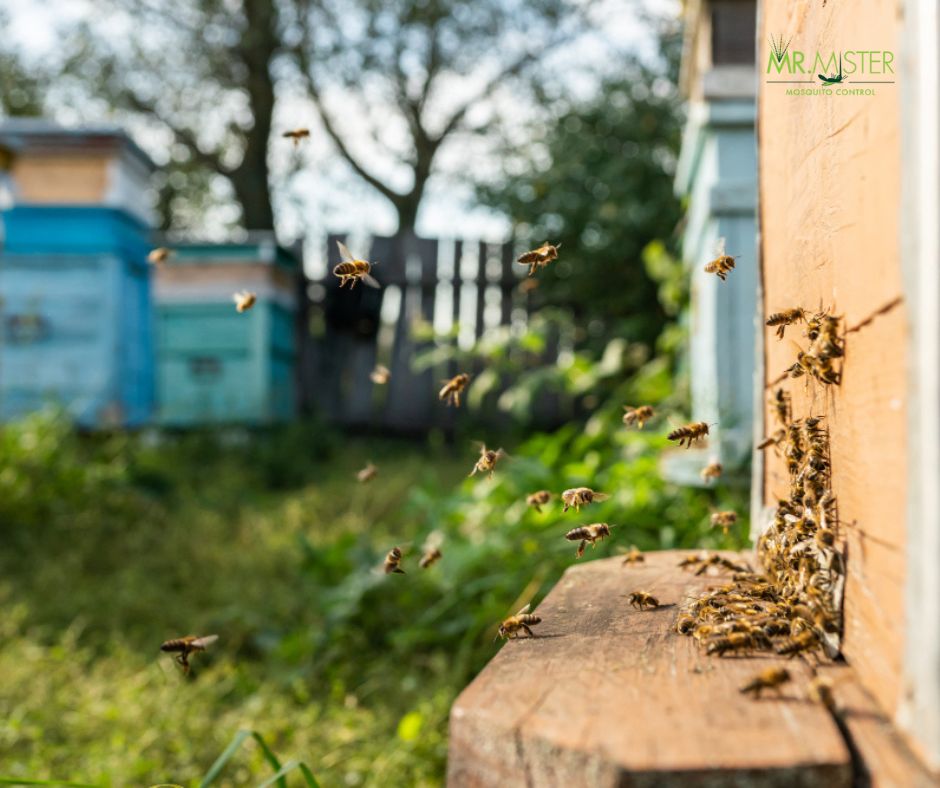Bee-Friendly Mosquito Abatement: Safeguarding Bees in Pest Control
Serving Atlanta, Georgia and Surrounding Areas
As concerns about mosquito-borne diseases continue to rise, communities often turn to mosquito abatement efforts to control mosquito populations. While these efforts are crucial for public health, they can inadvertently harm other important insects, such as bees. Bees play a vital role in pollination and maintaining ecosystem health, making it imperative to implement safe pest control practices that protect them. This article aims to provide valuable tips for ensuring the safety of bees during mosquito abatement activities.
Understanding the Importance of Bees:
Before delving into pest control practices, it’s essential to recognize the significance of bees in our ecosystem. Bees, particularly honeybees and native bees, are primary pollinators responsible for fertilizing flowers and crops, thereby facilitating the reproduction of plants. This process is vital for the production of fruits, vegetables, nuts, and seeds, which form the basis of our food supply. Additionally, bees contribute to biodiversity, supporting diverse ecosystems and maintaining ecological balance.
Challenges Posed by Mosquito Abatement Efforts:
Mosquito abatement efforts typically involve the use of various methods to control mosquito populations, including chemical pesticides, larvicides, and biological control agents. While these measures effectively reduce mosquito numbers, they can inadvertently harm non-target insects, including bees. Chemical pesticides, in particular, pose a significant risk to bees if not applied carefully and responsibly. These pesticides may drift onto flowering plants or contaminate water sources, exposing bees to toxic substances.
Tips for Protecting Bees During Mosquito Abatement:
Schedule Applications Carefully:
Coordinate mosquito abatement activities to minimize the impact on bees. Avoid spraying pesticides during peak foraging times for bees, which are typically during the early morning or late afternoon when temperatures are mild and bees are active.
Utilize Targeted Treatments:
Employ targeted mosquito control methods that minimize exposure to non-target insects like bees. Choose insecticides that specifically target mosquitoes while having minimal impact on beneficial insects. Biological control agents, such as Bacillus thuringiensis (Bt), can be effective against mosquito larvae without harming bees.
Implement Integrated Pest Management (IPM) Practices:
Adopt an integrated approach to pest management that emphasizes prevention, monitoring, and the use of multiple control tactics. By incorporating strategies such as habitat modification, mosquito surveillance, and biological control, communities can reduce the reliance on chemical pesticides and minimize harm to bees and other beneficial insects.
Provide Bee-Friendly Habitats:
Create and maintain bee-friendly habitats in urban and suburban areas to support bee populations. Planting diverse flowering plants in a bee friendly garden, including native species, provides bees with essential forage and nesting resources. Avoid using herbicides and insecticides in areas frequented by bees, such as gardens, parks, and natural habitats.
Educate the Public:
Raise awareness about the importance of bees and the potential risks posed by mosquito abatement activities. Encourage residents to take proactive measures to protect bees, such as avoiding the use of pesticides in their yards and supporting local bee-friendly initiatives.
Monitor and Evaluate:
Regularly assess the effectiveness of mosquito abatement efforts and their impact on bee populations. Monitoring bee populations and observing their behavior can help identify any adverse effects of pest control measures. Adjustments to treatment schedules or methods may be necessary based on monitoring results to better protect bees while still achieving mosquito control objectives.
Support Bee-Friendly Policies:
Advocate for policies at the local and regional levels that prioritize bee conservation and consider the potential impacts on bees when implementing pest control measures. Engage with policymakers, pest control agencies, and community stakeholders to develop guidelines and regulations that promote bee-friendly practices in mosquito abatement programs.
Collaboration with Beekeepers:
Establish communication channels with local beekeepers to coordinate pest control activities and protect bee colonies. Beekeepers can provide valuable insights into bee behavior and habitat preferences, helping to inform pest control decisions. Collaborative efforts between mosquito control agencies and beekeeping associations can facilitate mutual understanding and cooperation in safeguarding bee populations.
Invest in Research and Innovation:
Support research initiatives focused on developing alternative mosquito control methods that are effective yet environmentally friendly. Investing in innovative technologies, such as mosquito traps, biological control agents, and habitat modification techniques, can reduce reliance on chemical pesticides and minimize risks to bees and other beneficial insects.
Public Engagement and Outreach:
Engage the public through educational campaigns, workshops, and outreach events to raise awareness about the importance of bees and the need for bee-friendly pest control practices. Encourage community participation in bee conservation efforts, such as planting pollinator-friendly gardens, establishing bee-friendly habitats, and supporting local beekeeping initiatives.
Training and Certification Programs:
Establish training and certification programs for pest control professionals to ensure they are knowledgeable about bee biology, behavior, and the potential impacts of pest control measures on bee populations. By providing education and certification in bee-safe pest control practices, agencies can enhance the skills of their staff and promote responsible pest management.
Transparent Communication:
Maintain open and transparent communication with the public regarding mosquito abatement activities and their potential effects on bees. Provide clear information about the timing, location, and methods of pest control operations, as well as any precautions residents can take to protect bees on their properties. Transparency builds trust and allows for community involvement in bee conservation efforts.
Monitoring for Adverse Effects:
Establish mechanisms for monitoring and reporting any adverse effects of mosquito abatement activities on bee populations. Encourage residents, beekeepers, and other stakeholders to report incidents of bee mortality or unusual behavior following pesticide applications. Prompt investigation and response to such reports are essential for identifying potential risks and implementing corrective actions.
Continuous Improvement:
Commit to continuous improvement in bee-safe pest control practices through regular evaluation, feedback, and adaptation. Embrace a culture of learning and innovation, where lessons learned from past experiences inform future decision-making and actions. By continuously striving to refine and optimize pest control strategies, communities can minimize risks to bees and enhance overall effectiveness.
Long-Term Planning and Sustainability:
Incorporate bee conservation goals into long-term planning and sustainability initiatives at the local, regional, and national levels. Consider the broader ecological context and the interconnectedness of species when developing pest management policies and practices. By prioritizing biodiversity and ecosystem resilience, communities can create environments that support healthy bee populations alongside effective mosquito control measures.
Conclusion
Preserving bee populations is essential for maintaining healthy ecosystems and ensuring food security. While mosquito abatement efforts are necessary for controlling mosquito-borne diseases, they should be conducted responsibly to minimize harm to bees and other beneficial insects. By implementing safe pest control practices, communities can achieve effective mosquito control while safeguarding bee populations for future generations. Through collaboration and education, we can strike a balance between pest management and environmental conservation, ultimately benefiting both human health and biodiversity.
FAQs
Why is it important to protect bees during mosquito abatement efforts?
Bees play a crucial role in pollination and maintaining ecosystem health. Protecting bees ensures the continued pollination of flowers and crops, which is essential for food production and biodiversity.
What are some challenges posed by traditional mosquito abatement methods to bees?
Traditional methods such as chemical pesticides can harm bees if not applied carefully. Pesticides may drift onto flowering plants or contaminate water sources, exposing bees to toxic substances.
How can mosquito abatement activities be scheduled to minimize harm to bees?
Coordinate activities to avoid spraying pesticides during peak foraging times for bees, typically early morning or late afternoon when bees are active.
What are targeted treatments, and how do they protect bees?
Targeted treatments focus on specific pests like mosquitoes while minimizing harm to beneficial insects like bees. Choosing insecticides with minimal impact on bees or using biological control agents can achieve this goal.
What is Integrated Pest Management (IPM), and how does it benefit bees?
IPM emphasizes prevention, monitoring, and the use of multiple control tactics. By reducing reliance on chemical pesticides and incorporating strategies like habitat modification and biological control, IPM minimizes harm to bees.
How can individuals create bee-friendly habitats in their communities?
Planting diverse flowering plants, avoiding pesticide use in bee-populated areas, and supporting local bee-friendly initiatives are ways individuals can contribute to bee conservation.
What role does public education play in protecting bees during mosquito abatement activities?
Public awareness campaigns can help residents understand the importance of bees and the potential risks posed by pest control activities. Educated communities are more likely to take proactive measures to protect bees.
How can beekeepers and mosquito control agencies collaborate to protect bee colonies?
Establishing communication channels between beekeepers and pest control agencies allows for coordination of activities and sharing of valuable insights into bee behavior and habitat preferences.
What research initiatives are underway to develop bee-safe mosquito control methods?
Research focuses on developing alternative methods such as mosquito traps, biological control agents, and habitat modification techniques to reduce reliance on chemical pesticides and minimize harm to bees.
How can communities ensure transparency and accountability in mosquito abatement activities?
Maintaining open communication with the public regarding pest control operations, providing clear information about methods and precautions, and establishing mechanisms for reporting adverse effects are essential for transparency and accountability.
What steps can be taken to continuously improve bee-safe pest control practices?
Committing to regular evaluation, feedback, and adaptation ensures continuous improvement in pest control strategies. Learning from past experiences and embracing innovation minimizes risks to bees.
* Schedule a Free Mosquito Control Consultation – 404-941-0720 *
* Guaranteed Results * 100% Biodegradable * Locally Owned



